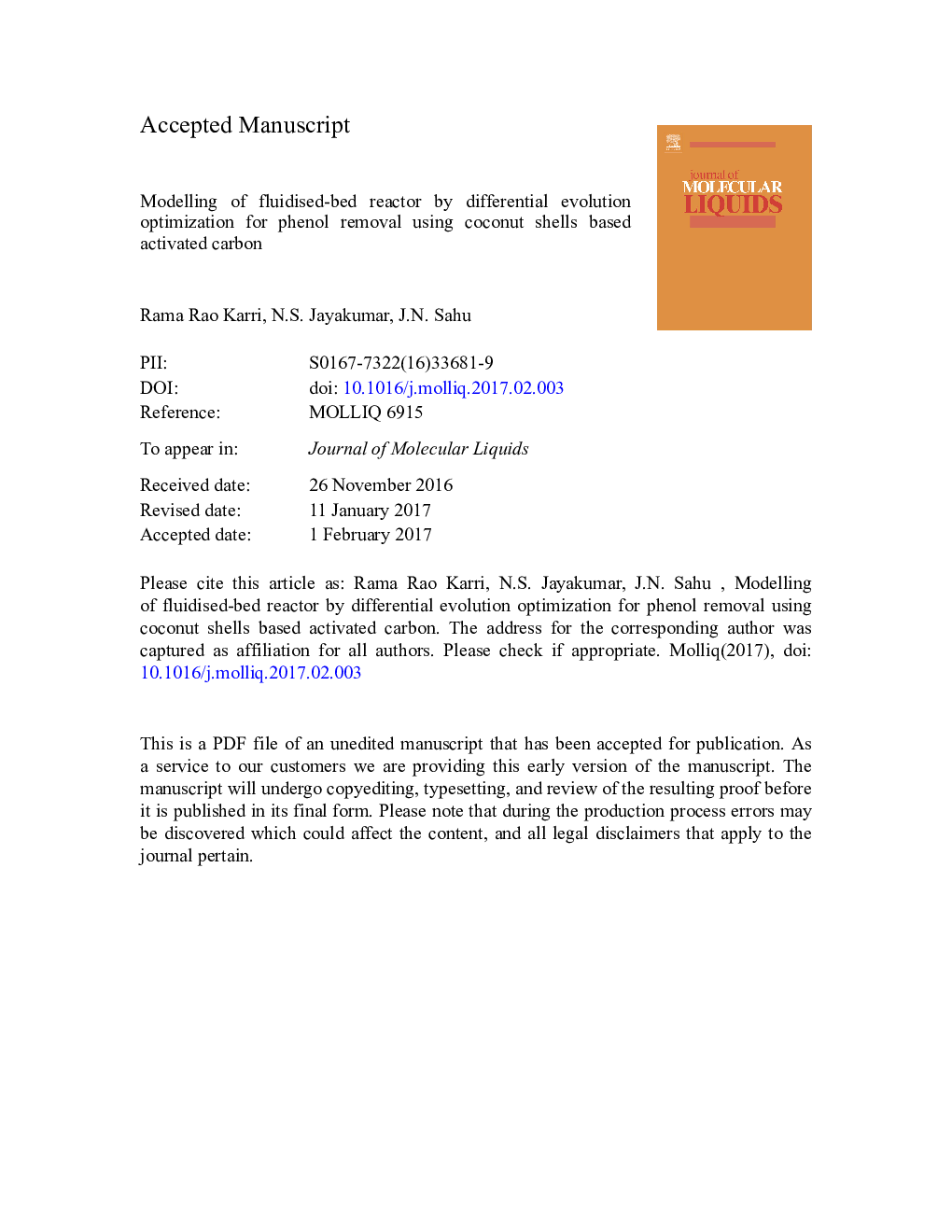| کد مقاله | کد نشریه | سال انتشار | مقاله انگلیسی | نسخه تمام متن |
|---|---|---|---|---|
| 5408715 | 1506540 | 2017 | 42 صفحه PDF | دانلود رایگان |
عنوان انگلیسی مقاله ISI
Modelling of fluidised-bed reactor by differential evolution optimization for phenol removal using coconut shells based activated carbon
ترجمه فارسی عنوان
مدل سازی رآکتور بستر مایع به وسیله بهینه سازی تفاضل تفاضلی برای حذف فنل با استفاده از کربن فعال بر پایه پوسته نارگیل
دانلود مقاله + سفارش ترجمه
دانلود مقاله ISI انگلیسی
رایگان برای ایرانیان
کلمات کلیدی
کربن فعال، تخت مایع مدل سازی، جذب، تصفیه فاضلاب، بهینه سازی دیفرانسیل،
ترجمه چکیده
فنل یکی از مهمترین آلاینده ها است که به منابع آب از صنایع تولیدی در صنایع نساجی، تولید پتروشیمی، پالایش نفت و غیره وارد می شود. این ترکیبات فنول محلول در آب هستند و بسیار سمی هستند و اثرات نامطلوب آن بر زندگی و محیط زیست دارد. حذف فنل ها از فاضلاب به دلیل مقررات سختگیرانه محیط زیست اجباری شده است. تکنیک جذب در مقایسه با سایر تکنیک های حذف آلاینده فرایند موثر است، در حالی که کاربرد آن محدود به دلیل هزینه بالای جاذب ها است. در این تحقیق، در یک رآکتور بستر مایع، هزینه های کم هزینه و به راحتی زباله های کشاورزی کربن فعال از پوسته نارگیل به عنوان جاذب مورد استفاده قرار گرفت، به منظور بررسی قابلیت و کارایی آن برای حذف فنل مورد استفاده قرار گرفت. پارامترهای عملیاتی مانند سرعت مایع سطحی، زمان تماس، غلظت فنل خوراکی و ارتفاع کربن تخت که بر عملکرد و خصوصیات یک رآکتور بستر مایع منجر می شوند، به طور سیستماتیک مورد تجزیه و تحلیل قرار گرفتند. اثربخشی راکتور برای حذف فنل با مطالعات جنبشی و تعادل مورد بررسی قرار گرفت. داده های جذب آزمایشی با استفاده از مدل های مختلف ایزوترم مورد بررسی قرار گرفت و مقادیر جذب پذیری مربوطه با مدل های سینتیکی خطی و غیر خطی تفسیر شد. یک روش جدید مدل سازی معکوس بر مبنای بهینه سازی تفاضل تکاملی برآورد پارامترهای جنبشی و مدل غیر خطی نشان داد که رابطه بین راندمان حذف فنل به عنوان یک عامل پارامترهای عملیاتی است. از مطالعات تجربی مشاهده شد که تقریبا 96٪ حذف فنل را می توان با بارگذاری کربن فعال پایین و همچنین زمان اقامت کوتاه تر به دست آورد. این نتایج تجربی همچنین نشان داد که کربن فعال بر پایه پوسته نارگیل یک جاذب ارزان تر برای حذف فنل از فاضلاب پساب است.
موضوعات مرتبط
مهندسی و علوم پایه
شیمی
شیمی تئوریک و عملی
چکیده انگلیسی
Phenol is one of the major pollutant released to water resources from manufacturing industries engaged in textile processing, petrochemical production, oil refining, etc. These phenolic compounds are water soluble and being highly toxic has adverse effects on aquatic life and environment. Removal of phenols from wastewaters has become mandatory due to stringent environmental regulations. Adsorption technique found to be effective process compared to other pollutant removal techniques, whereas its applications is limited due to high cost of adsorbents. In this research study, in a fluidised-bed reactor a low cost and easily available agricultural waste of activated carbon from coconut shells, were utilized as adsorbent to study its viability and efficiency for removal of phenol. The operating parameters such as superficial liquid velocity, contact times, feed phenol concentrations and carbon bed heights that influence the performance and characteristics of a fluidised-bed reactor were analyzed systematically. The efficacy of the reactor was evaluated for phenol removal with kinetic and equilibrium studies. The experimental adsorption data were examined by the various isotherm models and the corresponding adsorption rate values were interpreted with linear and non-linear kinetic models. A novel inverse modelling technique based on differential evolution optimization was implemented to estimate the kinetic parameters and non-linear model depicting the relation between the phenol removal efficiency as a function of operating parameters. It was observed from the experimental studies that almost 96% phenol removal can be achieved with lower activated carbon loadings as well as shorter residence time. These experimental results also revealed that coconut shell based activated carbon is a viable cheaper adsorbent for phenols removal from effluent wastewater.
ناشر
Database: Elsevier - ScienceDirect (ساینس دایرکت)
Journal: Journal of Molecular Liquids - Volume 231, April 2017, Pages 249-262
Journal: Journal of Molecular Liquids - Volume 231, April 2017, Pages 249-262
نویسندگان
Rama Rao Karri, N.S. Jayakumar, J.N. Sahu,
